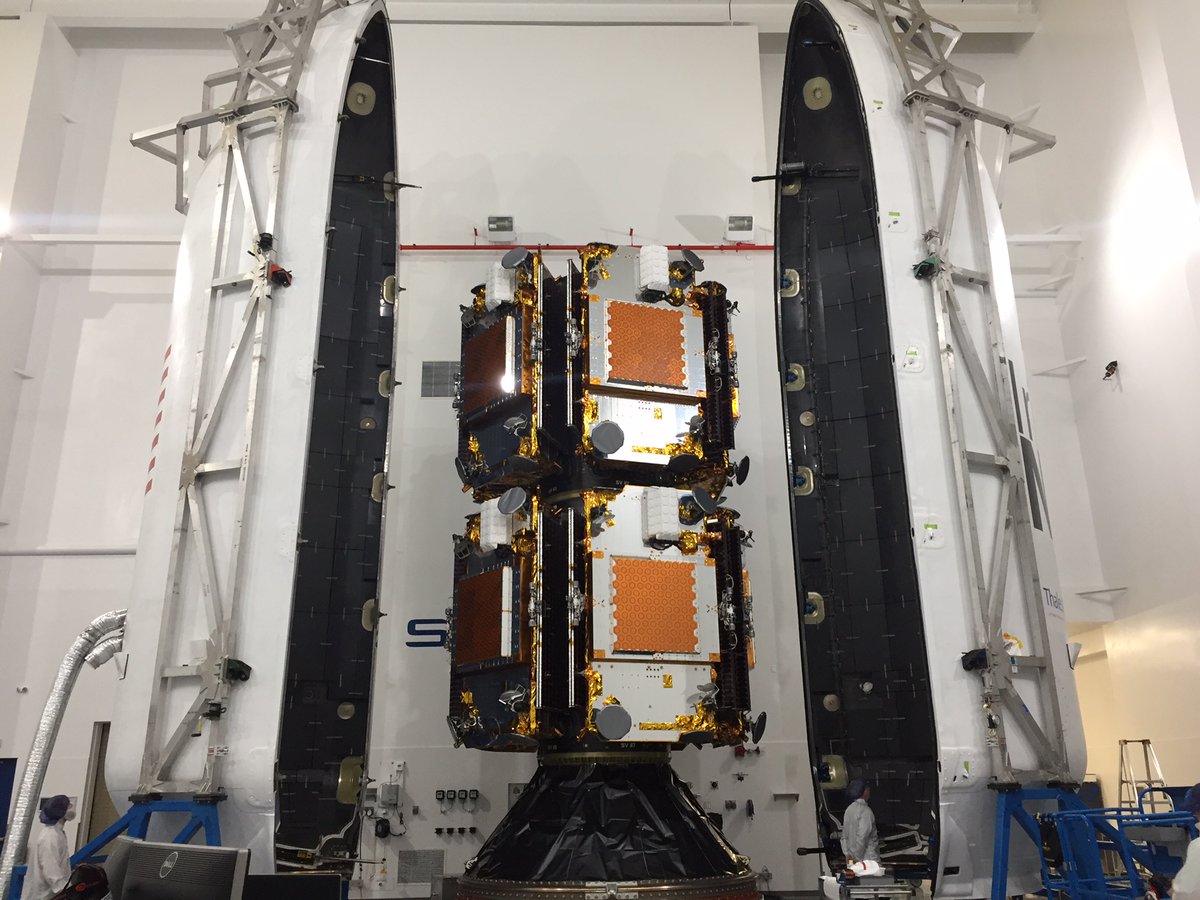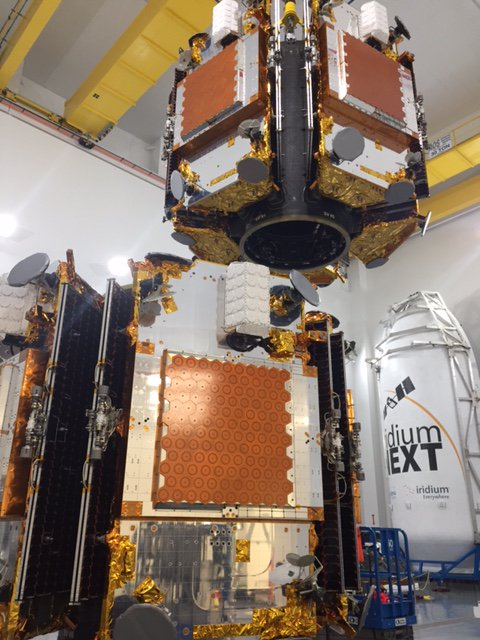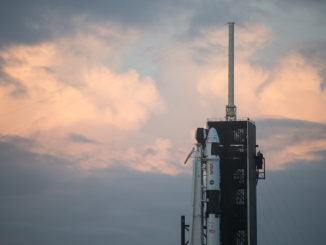
The first 10 satellites for Iridium’s next-generation mobile voice and data relay network have been fueled, joined with their deployment module and encapsulated inside the clamshell-like nose cone of a SpaceX Falcon 9 booster for launch as soon as next week from Vandenberg Air Force Base in California.
SpaceX and Iridium have not announced a target launch date, but engineers are aiming to have the mission ready for liftoff by Jan. 7. That schedule is still very preliminary.
An official target launch date is pending the Federal Aviation Administration’s approval of the SpaceX-led investigation into the explosion of a Falcon 9 rocket on a launch pad at Cape Canaveral on Sept. 1, which destroyed the Israeli-owned Amos 6 communications satellite awaiting liftoff a few days later.
SpaceX missions have been grounded since the explosion. The California-based launch company, founded and headed by Elon Musk, hoped to resume launch services by the end of 2016, but the investigation, launch preparations, and the FAA’s review of the Sept. 1 mishap pushed the Falcon 9’s return-to-flight into January.
The launch of Iridium’s first 10 next-generation communications satellites, the first part of an eventual network of 81 spacecraft, was next in line on SpaceX’s manifest at the time of the Sept. 1 explosion.
Meanwhile, construction crews at Kennedy Space Center’s launch pad 39A in Florida are finishing up modifications to the former space shuttle launch complex to support Falcon 9 flights as soon as late next month.
The launch facility used by SpaceX’s previous missions from Cape Canaveral, Complex 40, suffered major damage after the Sept. 1 rocket explosion, the first such on-the-ground mishap at the Florida spaceport since the early years of the Space Age.
All of SpaceX’s near-term launches from Florida will take off from pad 39A.
But the launch for Iridium from California’s Central Coast is first in line as final preparations are nearing completion inside SpaceX’s hangar at Space Launch Complex 4-East, a hillside facility overlooking the Pacific Ocean.
Within the last week, technicians from satellite-builders Thales Alenia Space and Orbital ATK have filled all 10 “Iridium Next” satellites with hydrazine fuel used to maneuver the spacecraft once in orbit.
The satellites are mounted on a deployment module developed by SpaceX specifically for the Iridium missions to be flown on Falcon 9 rockets. SpaceX is under contract to launch at least 70 Iridium Next satellites through early 2018, primarily in batches of 10 at a time.
Launch arrangements for the remaining Iridium Next satellites, which are built as spares, have not been announced.
The mounting system is made up of two tiers, each holding five satellites. Ground crews inside the SpaceX payload processing facility at Vandenberg have stacked the two tiers and encapsulated the satellites inside the Falcon 9’s payload fairing, which is emblazoned with the Iridium logo.
After the Falcon 9 rocket completes its pre-flight “static fire” test on the launch pad — the same test that resulted in the explosion in Florida on Sept. 1 — the 10 Iridium Next satellites will be mated with the booster for liftoff.

Once the Falcon 9’s second stage reaches a polar orbit around 388 miles (625 kilometers) above Earth, the 10 signals relay stations will separate from the deployment module to begin three months of tests to check the health and function of spacecraft systems, ground and inter-satellite communications links, and tack-on instruments to track global air and maritime traffic.
The satellites will maneuver into the operational Iridium constellation at an altitude of 485 miles (780 kilometers), replacing the company’s 66 existing satellites one-by-one.
One of the Iridium Next launches in the fourth quarter of 2017 will only carry five Iridium Next satellites. The rest of the Falcon 9’s lift capacity will be taken up by two U.S.-German gravity research spacecraft, a follow up to the Gravity Recovery and Climate Experiment, or GRACE, satellites launched in 2002.
The GRACE-Follow-On mission was supposed to launch on a Russian-Ukrainian Dnepr rocket, but that program’s future is in doubt in the wake of Russia’s annexation of Crimea and military activity in eastern Ukraine. Russian officials have said they plan to discontinue Dnepr launches.
Managers from the German Research Center for Geosciences in Potsdam, or GFZ, switched the GRACE-FO mission to a Falcon 9 rocket launch. The German research center is partnering with NASA on the mission.
The Iridium Next launch in early January will mark the third Falcon 9 mission from the West Coast complex, and the 29th Falcon 9 launch overall since SpaceX’s workhorse booster debuted in June 2010. One of the Falcon 9 flights is counted as a failure, not including the vehicle lost on the launch pad Sept. 1.
SpaceX founder and chief executive Elon Musk told CNBC last month that investigators believe they have narrowed the likely cause of the Sept. 1 mishap to a problem during filling of the rocket’s second stage with super-cold liquid oxygen.
The explosion occurred about eight minutes before the Falcon 9’s engines were to ignite during a hold-down test.
The oxygen likely froze solid and caused a high-pressure helium tank to burst, blowing the upper stage apart almost instantly, and leading the rest of the rocket to collapse in a fireball. The helium is used to pressurize the second stage’s propellant tanks for flight.
Musk said engineers believe they can fix the problem with a change in fueling procedures, avoiding major hardware changes that would have kept SpaceX missions grounded longer.

The upcoming launch is a big step for Iridium, which is spending $3 billion on the new satellite program. Iridium’s current satellite network is aging — the old spacecraft launched between 1997 and 2002 — and needs an upgrade.
“There were many challenges on the program, from orbit determination knowledge design, to encryption design, to integration and verification test planning, to planning for on orbit acceptance activities, but the team made it all come together and the satellites are ready for deployment to enhance the future of mobile satellite communications — I could not be more proud,” said Joel Rademacher, director of systems engineering for the Iridium Next program.
With a full load of propellant, each satellite weighs nearly 1,900 pounds (860 kilograms), and when combined with the specially-designed multi-spacecraft mounting dispenser, the Iridium Next package will be weigh in at more than 20,000 pounds, the heaviest payload launched by SpaceX to date.
SpaceX intends to recover the Falcon 9’s first stage booster on a barge positioned south of Vandenberg in the Pacific Ocean, a continuation of the company’s efforts to master vertical rocket landings and reusability.
Email the author.
Follow Stephen Clark on Twitter: @StephenClark1.



